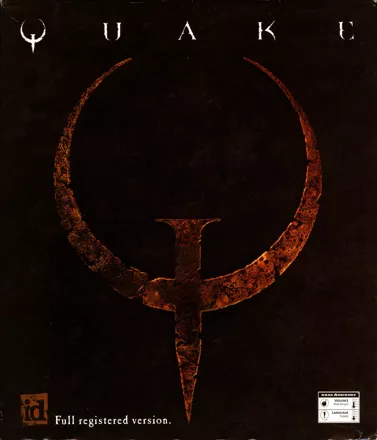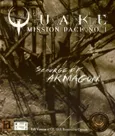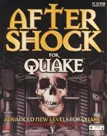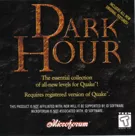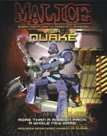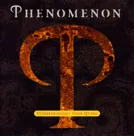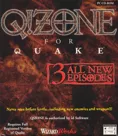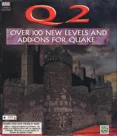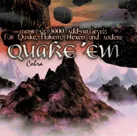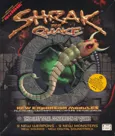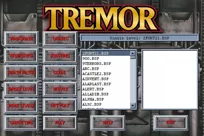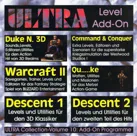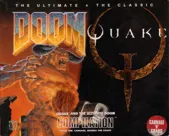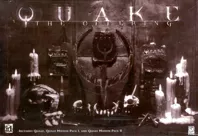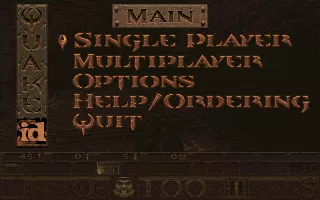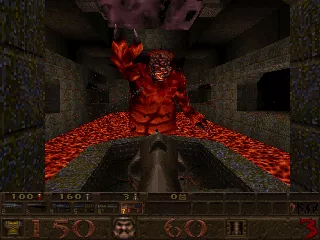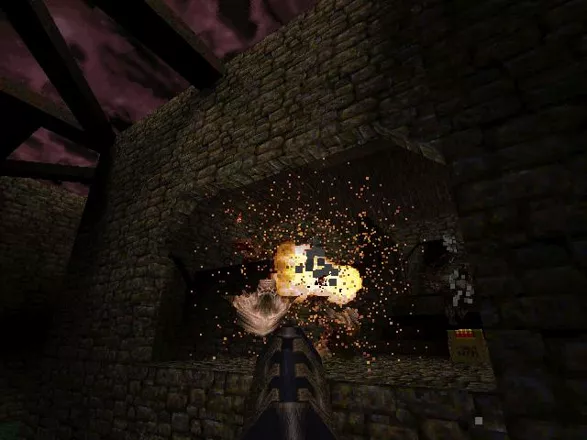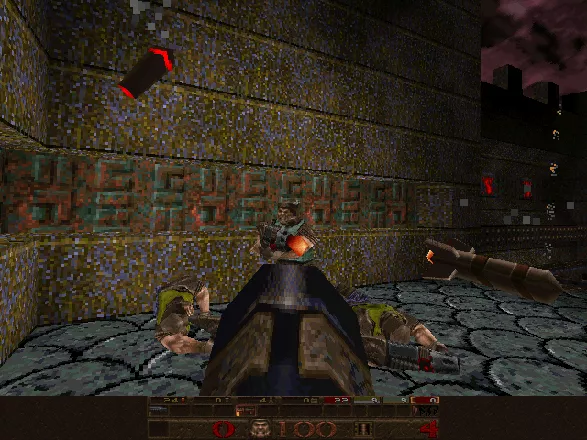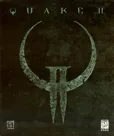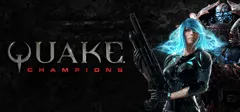Quake
-
 Quake
(2021 on
Windows,
Windows Apps,
PlayStation 4...)
Quake
(2021 on
Windows,
Windows Apps,
PlayStation 4...)
Description official descriptions
An enemy with the codename ''Quake'', which is believed to come from another dimension, is using teleporter gates to invade Earth. The player takes the role of a nameless soldier who arrives at his base only to find out Quake has overrun it and killed everyone. Somewhere in the base, there must be a teleporter to Quake's realm. The mission is clear: take the fight to the enemy, overcome countless hordes of monsters, and exact revenge.
id Software's follow-up to Doom and Doom II, Quake is a first-person shooter. Its main technological innovation is the use of a true 3D engine - the levels themselves, as well as the enemies, are polygonal. This not only allows for more natural level-designs and character animations, but also for more realistic lighting and the inclusion of simulated physics that have an effect on gameplay: grenades can bounce off walls and around corners, for example.
In single-player mode, gameplay consists mainly of proceeding through the levels (spread over four distinct episodes) in search of an exit, killing everything that moves. Interaction with the game world is reduced to a minimum: since there is no use key, buttons are pressed by running into or shooting at them. As in id's earlier games, many secrets are waiting to be discovered, including a few hidden levels.
Unlike Doom's rather straightforward design that couples futuristic environments with demonic imagery, the theme of Quake's levels, enemies, and weapons is not so easily pinpointed. While each episode begins in a futuristic military base (with a technological 'slipgate' as the level exit), later levels take place in environments inspired by medieval fantasy and gothic horror (castles, dungeons, and caverns) and the player passes through magical portals to advance. In a departure from Doom's colorful environments, all Quake levels are dominated by earth colors.
The enemies conform to the mishmash of designs: there are human opponents armed with shotguns and energy weapons in the early levels, while the later levels include medieval knights, ghosts, zombies, ogres (armed with grenade launchers and chainsaws), and some more unearthly beasts. The player's weapons, while relatively modern, all have a low-tech feel. Besides a (bloodstained) axe, there are shotguns, nailguns, rocket and grenade launchers, and the Thunderbolt, which discharges electrical energy.
Quake was one of the first games playable natively over the Internet in addition to LANs. The single-player levels can be played cooperatively, but the game is most famous for its deathmatch mode. One-on-one duels, team play, and free-for-all competition are possible. The emphasis is on fast reaction and skillful maneuvering through the levels. All of the single-player maps can be used as arenas, but the game also comes with six maps specially designed for deathmatch.
Spellings
- 雷神之锤 - Simplified Chinese spelling
Groups +
- 3D Engine: Quake
- 3D Engine: SlaveDriver
- BPjS / BPjM indexed games
- Game feature: In-game screenshot capture
- Gameplay feature: Drowning
- Gameplay feature: Recordable replays
- Games with Dopefish
- Games with officially released source code
- Inspiration: Author - H. P. Lovecraft
- Online Service: Heat.net
- Quake series
- Replay (GT / Infogrames / Atari) releases
- Total Entertainment Network (TEN) multiplay platform
Screenshots
Promos
Videos
Add Trailer or Gameplay Video +1 point
See any errors or missing info for this game?
You can submit a correction, contribute trivia, add to a game group, add a related site or alternate title.
Credits (DOS version)
27 People (15 developers, 12 thanks) · View all
| Programming | |
| Tools Programmer | |
| Level / Scenario Design | |
| Music | |
| Sound | |
| Project Manager | |
| Support | |
| Biz | |
| Biz assist | |
| Special Thanks To | |
| [ full credits ] | |
Reviews
Critics
Average score: 87% (based on 61 ratings)
Players
Average score: 4.0 out of 5 (based on 465 ratings with 19 reviews)
Great engine!! Great multiplayer code!!... Game? What game???
The Good
Quake was a technological wonder, after Doom id really had a hard act to follow technology-wise, yet they once again proved their programming prowess with Quake = the first fps with a true 3D engine.
And what an engine it was! After years of being stuck on the world of 2.5D games, Quake finally delivered true polygonal bliss. The end result was pretty much obvious: better sense of space and depth, smoother animation, use of effects like the portal or the cool underwater-distortion one, etc. etc. Quake also applied it's 3D-ness to such things as the player's Pov, which swayed and leaned around quite realistically. A feat that really made the game feel a lot different from the now static-looking 2.5D fpss; ditto the character models, which moved way smoother than sprites, and also came with the added bonus of being able to explode in little chunks of red meat, yes boys and girls, "gibs" were born with Quake.
The multiplayer area is also the other point were Quake broke the mold. As everyone knows by now, the game replaced all the hassle of multiplayer net-play with the now common server-client architecture, which was not only much more intuituive, but also much more reliable and fast, especially when you consider the setup prep-work that was usually involved with multiplayer gaming.
Also, being a metal fan I really enjoyed NIN's contribution to the game's soundtrack, tough it seems to be too depressing/experimental to most players for some reason. Still, if you don't like it, you can always pop in your own audio cd and let 'er rip while you get it on.
The Bad
What "didn't" I like about the game?? Well, there's no game to speak of!! :)). Seriously, Quake would begin id's trend of just forgetting about game design and instead providing the best technological wonders they could come up with. This is especially evidenced by the open architecture of Quake. It's set-up so you can customize it to your liking, ad mods to it, ad skins, textures, levels, sounds, etc etc. Heck, they even released the source code!
Id just figured "Why the hell bother designing the game when we just can release the technology?" It may be a reprehensible idea, but it's smart! Think about it, Quake off the box was a piece of shit. The game itself has even less story than Doom (and you thought that wasn't possible!!), the weapons are copies of Doom's (save for the Axe and the Lightning-throwing thingie) with new yet crappy 3D models (the rocket launcher is just a brown rod!!), the level of interaction was toned down to near-retarded levels with the removal of the use key in favor of a jump key, essentially trading off the ability to use things for the world's crappiest jump (primary reason for the discovery of the rocket-jump) result? You activate gigantic buttons by bumping into them... groan....
But wait! That's not all! The levels are dull techo-goth places with a heavy dose of the brown color (hmmm, crap comes to mind in more ways than one!!), populated by stupid traps (??WTF??) and seemingly randomly-placed enemies, which to be fair are the only cool things that come with the game. The single player campaign is a joke, with the only good moment being the fight against Chthon at the end of episode 1 and the initial joy of watching everything in 3D and all the Lovecraftian imagery. The multiplayer part saves the game, but then again the maps that came with the game were sorely lacking in just about every level.
...yet...
The Bottom Line
Quake sold Gazillions of copies!!! Why? Because it didn't matter whether it was good or not off the box!! You bought the game, and then turned it into whatever you wanted! And I'm not just talking about the level add-ons and stuff like that, I'm talking about serious reworkings, like Quake Rally and the like.
Quake is sort of like a piece of real estate, get it? It's what you put in there that eventually turns the game a worthy experience. It's a piece of remarkably well made technology, with enough of an open architecture to satisfy most pseudo-designers (though it would still require a high level of proficiency to do stuff like "real" level editing). That's what you pay, and that's what you get. Not a game, but a 3D-enginered, multiplayer-capable, piece of clay. This is good, REAL good. On the other hand it's pretty shameless in the sense that the developers simply washed their hands of most, if not all, creative content... hmm. That's bad, real bad...
In the end you'll have to ask yourself what do you really want. Back on those days Quake meant 3D and multiplayer. If you wanted that, you went for that. If you wanted say... good fps gameplay, you went for Duke3D (or even Quake add-ons like Scourge of Armaggon) and the like. You had to think before you bought. Of course, nowadays it's just completely stupid to play Quake. No reason to bother with old technology when you can have the new and upgraded version: Quake 3 Arena, even less of a game than this one, and destined to the same oblivion as soon as Quake 4, 5, 6, etc. get released.
DOS · by Zovni (10504) · 2002
3D engine for sale! 3D engine for sale! (oh yeah, there's a game here too)
The Good
The Quake Id Software intended to make was quite different to the Quake that actually got released. 1995-era gaming magazines were awash with hype about a fully 3D, fantasy-themed FPS with detailed lighting effects and morphable terrain and an RPG-style class system and everything but the kitchen sink.
Somewhere along the line id's development team must have realised that the hardware required for this sort of game did not exist yet. They ended up releasing a stripped-down tech demo that was only a shadow of what they had originally promised. It is completely 3D, but just about everything else was sacrificed to make it 3D.
Everywhere in Quake you see the signs of a game laboring under technological constraints. The levels are absolutely tiny, and mostly made up of cramped rooms and corridors (large outdoor areas like in Doom? Forget it.) The textures are bland and of low detail. The tradeoff for realistic lighting was that everything in the game is rendered in dull browns and grays. It's rare that you'll have three enemies on the screen at once. Five enemies is a gratuitous bloodbath.
Thematically the game is a continuation of Doom. The settings and plots are pretty much the same: you are a marine who is the last man standing on the site of an alien invasion. But rather than the Aliens setting of Doom, Quake is far more Gothic. Castles and dungeons are the rule here rather than space stations and moon bases. In fact, you could easily believe that this game was originally intended to be set in the Middle Ages.
The action is fast and lean. The monsters are weak but deal out massive damage, and since you don't have much ammo the game becomes a frenetic and tense reflex match. The game's realistic lighting works in its favor by giving monsters the ability to hide in shadows where you can't see them. The game's scariest moments come when you're walking down a well-lit corridor and suddenly the lights go out...and you can hear growls and snarls.
Quake's monsters are pretty cool and one of the best things that came with the game. There are zombies, werewolves, and flesh-eating fish, and lethal killing machines such as the Hell Knights and Vores. But pride of place is reserved for the Shambler, a hulking behemoth who can shoot lighting and absorb massive amounts of damage before dying; and can be regularly found on "Best Ever Monster" lists around the net.
The game's 3Dness makes it aesthetically incomparable to the 2.5D games of the day. Perspective is rendered correctly. There can be rooms on top of rooms. Your viewpoint can lean and rotate at any angle. You can look straight up at the sky. You even have the ability to swim underwater! These things gave the game the needed wow factor to become a hit, and just as well because that's all Quake has going for it.
The Bad
Like I mentioned before, the content side of the game was severely hamstrung so they could get it in 3D. Basically, everything about the game unrelated to technology sucks.
There is no story, and zero originality. Even though the FPS genre was only a few years Quake effectively stagnated it with boring levels, hardly any features, repetitive and derivative design, etc. This is the first game I can think of that was literally designed around its engine and graphical capabilities. Take away the 3D-ness, and Quake is worthless bargain bin material.
The levels themselves are so factory-produced and generic they might as well have been generated by a macro. The game over-uses the "monsters hiding in shadow" trick until it's not funny anymore (and the game has an annoying habit of spawning monsters behind you, the precursor of Doom 3). You'd think that with fully 3D terrain the door would be open for all sorts of cool levels, but for the most part Quake's levels are the same as Doom's levels: lots of hallways and staircases and the occasional elevator.
Weapon balance is way off, the hatchet is a worthless piece of crap and once you get the rocket launcher you're set for the whole game. And the game has a "weak, medium, strong" approach to weaponry, so that if you get a super shotgun your regular shotgun becomes useless and if you get a super nailgun your old nailgun becomes useless. The result? There are eight weapons in the game but you only ever use two or three of them. What's the point?
There's no originality, no attempt at a story, and nothing that advances the FPS genre at all. Any last chance of Quake being a good single-player game is drop-kicked in the nuts by a moronic final boss fight. I'm not one for hyperbole, but Quake has the lamest, most anti-climactic boss fight of any Id Software game (and that includes Commander Keen!). Shub Nigguruth is a giant blob that does not even move but just sits there doing nothing while you run around and kill a few monsters (like you've been doing all game) looking for a hidden switch that kills the boss and ends the game. And as a final insult, there isn't even an ending cutscene.
Although much can be said of the game's technology, Quake is not a pretty game. As mentioned before, the color palette is extremely limited and the whole game is brown and gray. The polygons are blocky and the monster animation is very choppy. Probably the best thing one can say about Quake's graphics is the distortion effects underwater, and the lighting. And although some would call Quake a masterpiece of Gothic horror, praising Quake for being dark and suspenseful is like praising a 1920s-era film for being sepia-toned and artsy. It only looks like that because of technological restrictions, and attempting to translate that into artistic genius on the part of the creators is nothing more than Emperor's New Clothes syndrome.
But wait! What about multiplayer? The game was a huge multiplayer hit over the internet, partly because it was so easy to set up and find opponents. But the game's rushed design can be seen here as well, as almost all the maps that come with the game are crap and full of bugs and imbalances (example: in one of the levels there is a 100% health powerup, a super nailgun and a quad damage right next to each other). Not to mention that Quake only started to become really popular after user mods had ironed out all the nuisances and issues, basically a continuation of Id's policy of "let the community fix our games for us". Hardly anyone plays Vanilla Quake.
The Bottom Line
There's a problem with engine games: they are only as good as the engine that powers them. As soon as the technology starts to become old, the game itself becomes obsolete. On the other hand, great gameplay never dies: look at how many people are playing Duke Nukem 3D after all these years. But Quake is dead armadillo. It was boring in its day and is even more so now.
DOS · by Maw (832) · 2007
The Good
This game is a legend, and anyone that even remotely loves online deathmatch, CTF, or other FPS type games should know what I'm talking about.
First of all, the graphics for the time period are simply amazing. I can remember running this game on a 4 meg Diamond Monster 3d card and it was blazing fast and quite simply beautiful. The sound and music are top notch as well, and Trent Reznor (of Nine Inch Nails fame) takes credit for that.
Next, the level design is fantastic. Playing deathmatch and arena or other mods reveals just how well thought out the levels are. American McGee among others are responsible for very well planned environments. You can tell that this game wasn't just thrown together, and one can even imagine Id's offices a big mess with drawings and print outs in regards to level design posted all over the walls.
Furthermore, the game is fully customizable. Quake is either the first, or one of the first games to feature the use of the console in game (something that is now standard on all FPS games). With a little instruction one could enter commands into the console to alter the settings of the game in real time. There was so much versatility and control given to the user, that you could even manipulate the way your online connection functions (like eliminating delta from the tcp/ip function with commands like cl_nodelta 1), what information is given to the player, which models are drawn on the screen and which aren't, the list is exhaustive and goes on and on. The level of customization afforded to the end user was so powerful that Quake could run on just about any machine, and not only that but look and play entirely different on different PC's.
The multiplayer is unbelievably fast. I used to ping 16 with an ISDN connection, and had a friend on 56k that could ping 90. Yes, with some in game tweaking ultra low pings were possible. Furthermore, you could be in a big deathmatch, rockets flying all over the place and 6 or 7 people on your screen with the settings maxed out, and never have your ping move or your framerate drop, all while playing on a p133 with 64mb RAM and a 4meg video card. Phenomenal!
The deathmatch modes are the real meat an potatoes here. I've yet to find any DM type FPS games that are as fast or as hardcore as this game. There isn't much in the way of fancy items or powerups save for some armor, extra health, and occasional quad damage or invulnerability. This game requires raw skill, precision aiming, and knowledge of map layouts all of which take months or even years to perfect.
There are lots of user created maps and add-ons. Clan Arena and Rocket Arena, along with QuakeWorld were my favorite mods, but they also had Team Fortress and other ambitious mods. Now that the game is open source, the sky is the limit.
The Bad
The single player game is weak and mostly worthless. I had first played in single player mode and this made me quit the game for a couple of months until I started hearing from everyone about how untouchable the multiplayer was.
Learning console commands might be discouraging to some, but then again knowledge of their function is not a requirement for play. On the other hand, to have any chance of success during serious competition a working knowledge of the commands is a must, and a .cfg file must be tested and tweaked ad naseum in order to achieve one's full potential. This can be good or bad depending on your disposition.
Some complained that the colors were drab and got old. Lots of shades of brown and gray throughout the levels.
The Bottom Line
Quake is the single best DM game hands down, even today. Even though it was released in 1996, people are still playing it regularly, although the online population is only a fraction of the size it used to be. I played the game from 1996 to 2004 when I finally retired, and there were still big clans, ladders, competitions, and public and private servers available. The speed of the game, multiplayer code, meat and potatoes deathmatch, and customizing options have made this game one I'll never forget.
DOS · by D Michael (222) · 2007
Discussion
| Subject | By | Date |
|---|---|---|
| Paul Steed credit | leilei (343) | Aug 13, 2012 |
| What music? | null-geodesic (106) | Jun 12, 2008 |
Trivia
1001 Video Games
The PC version of Quake appears in the book 1001 Video Games You Must Play Before You Die by General Editor Tony Mott.
Scrapped versions
The Game Boy Advance version of Quake was in development by AGB Games. There were also plans for port to Sony PlayStation by Lobotomy Software, which was able to work, under some circumstances, in 60 FPS. First one was cancelled for unknown reasons, while second cancellation was caused by fact, that developer failed to find a publisher.
3D cards support
The original game had software rendering mode only. You could download glquake to use your 3d accelerated card. A special version was made for the intergraph rendition cards called vquake.
Anaconda level
Bizarre product tie-ins: for the release of the movie Anaconda, Sony pictures released through their website an add-on level for Quake titled Temple of the Mist were you made your way trough an ancient temple searching for the altar that holds the key to escape. Obviously, before escaping you have to go mano a mano with the Anaconda itself...weird uh?
Development
The original Quake was supposed to have a medieval environment, but a few months before its release, most of the medieval-role playing aspects of the game were removed (i.e. one of the weapons was going to be a sword and there was a dragon to fight with) and the result was a game with guns but such enemies like the fiend or the death knight (these were included in the original project). Many original design elements were scrapped -- the kernel idea behind Quake was this massive Thor-like warhammer that you could slam down on the ground to make shockwaves ripple through the game world. This "ultimate weapon" idea followed John Romero to his game Daikatana.
The original concept was inspired by a character named Quake in id's long D&D campaign (which actually ended with demons destroying the universe due to John Romero's greed), DM'd by John Carmack. Because of the switch to sci-fi, Romero was angry enough to leave id after Quake, even though Carmack fired him first. He later used another inspiration from the D&D campaign to make Daikatana.
Deathmatch
Kornelia, a famous female Quake player, won the "TEN GibFest Contest" at the computer game developers conference at Santa Clara. As a result, she was afforded the opportunity to play John Romero in a 1v1 deathmatch. She beat him 22 to 1 and also took home a P200 MMX system.
Dopefish
Quake is yet another of id Software's games that contains the infamous Dopefish. The level you can find the Dopefish on is E2M3, The Well of Wishes, in a secret location that you'd probably need a walkthrough to get to. Incidentally, "The Well of Wishes" is the same title as a Commander Keen 4: Secret of the Oracle level where the Dopefish first appears.
Engine
The engine that iD Software started to make Quake with was called Six Degrees of Freedom
German index
On August 31, 1996, Quake was put on the infamous German index by the BPjS. For more information about what this means and to see a list of games sharing the same fate, take a look here: BPjS/BPjM indexed games.
IFQuake
Taking John Romero's work on the Apple ][ bootloader for Infocom's Zork Zero as a point of departure, in 2004 Jason Bergman released IFQuake -- the difficulty-selection stage and first level of the shareware version of Quake implemented as a text adventure game, downloadable at http://mirror.ifarchive.org/if-archive/games/zcode/ifquake.zip
Innovations
Almost incidentally, Quake introduced the now-standard concept of a FPS 'console', and popularised 'mouselook' as *the* absolute standard control interface. Although the specifications required a Pentium, Quake ran acceptably well on a 486 DX4/100 and, at a push, the faster 486es. Along with Magic Carpet it was however the game that most established the Pentium as a must-have processor. It was also the first game which offered the opportunity for both Amiga and PC gamers to play online together.
Machinima
Machinima, an animated film using the 3D environment of a game, started with the Quake engine. Doom already had a recording feature, but it wasn't until Quake when people added narrative and called it "movies" that the genre was born. The first known machinima is Diary of a Camper, by a group of players called The Rangers, released on October 26, 1996.
Qtest1
Quake was preceded by Qtest1, a tech demo which was released in February 1996. It consisted of three small, monster-free levels which illustrated the game's engine. Of particular note was Test3, which became the basis for the second level of Quake's first episode (of the other levels, Test2 seemed to be a very, very early incarnation of 'Ziggurat Vertigo', the infamous low-gravity secret level). The engine was almost fully complete, although wall-mounted torches were still sprite-based.
Although the test had no game - rather like the original Doom 'alpha releases' - multiplayer support was, fortunately, included. The infamous 'rocket jump' was discovered quite quickly, as Qtest included both rocket and grenade launchers.
"Chris ([email protected])" eventually discovered that monsters were included in the game's source code, and a patch released in June 1996 allowed players to experience early versions of Quake's beasties.
References
All of the sounds and music for Quake were produced by Trent Reznor, the man behind the industrial/alternative group Nine Inch Nails. The ammo boxes for the nailgun ("nails") have the band's logo (NIN) on the side.
References to the game
One of the songs on Karl Sander's album Saurian Meditation, "Elder God Shrine", was named after the Quake level E4M3 which has the same name.
Saturn version
The Saturn version of Quakeis the only version with coloured lighting, something Lobotomy Software added to the saturn version
Source code release
In 1999, id Software made the complete source code for Quake freely available to the public. You can download it here.
Speedruns
Quake inspired the art of speedruns: trying to beat a game as fast as possible. The initial release was Quake Done Quick, completed in 19:49 and released on 1997. As of 2012, players still work on breaking the latest records.
Zeeboo version
On June 15, 2010, both Quake and Quake II were removed from Zeebo's wireless network, the Brazilian Zeebonet. Both games were offered for 10 Z-credits and each Brazilian Zeebo came with 35 Z-credits, so the games were sold virtually for free. They were replaced for Zeebo Extreme Rolimã and Zeebo Extreme Jetboard as free downloads.
Awards
- Computer Gaming World
- November 1996 (15th anniversary issue) - #36 in the “150 Best Games of All Time” list
- November 1996 (15th anniversary issue) – The Best Way To Die In Computer Gaming (being telefragged)
- November 1996 (15th anniversary issue) –Worst Back Story of All Time
- November 1996 (15th anniversary issue) – #5 Least Rewarding Ending of All Time
- May 1997 (Issue #154) – Action Game of the Year
- May 1997 (Issue #154) – Action Game of the Year (Readers' Choice)
- May 1997 (Issue #154) – Special Award for Technological Achievement (for its engine)
- April 1999 (Issue #177) - Introduced into the Hall of Fame
- March 2001 (Issue #200) - #8 Best Game of All Time
- GameSpy
- 2001 – #5 Top Game of All Time
- GameStar (Germany)
- Issue 12/1999 - #7 in the "100 Most Important PC Games of the Nineties" ranking
- PC Gamer
- April 2000 - #14 in the "All-Time Top 50 Games" poll
- April 2005 - #26 in the "50 Best Games of All Time" list
- Power Play
- Issue 02/1997 – Best Multiplayer Game in 1996 (together with Jagged Alliance: Deadly Games)
- Świat Gier Komputerowych
- February 1997 (Issue #50) – readers' award Hitek'96 for the best foreign game of 1996
Information also contributed by Adam Baratz, Ashley Pomerov, chirinea, Darksaviour69, D Michael, Erkan O; keth, Maw, n-n, PCGamer77, Pseudo_Intellectual; Sciere, Scott Monster, Xoleras, Zack Green and Zovni
Analytics
Upgrade to MobyPro to view research rankings!
Related Sites +
-
FitzQuake
The most faithful custom engine available. -
Func_Msgboard
An ever-active forum dedicated to custom mapping, primarily focusing on the original game but also covering the following games in the series from time to time. -
Matt Chat 54
Video interview with John Romero about the development of Quake -
Planet Quake
An exhaustive quake site visit it for news, mods, levels, tips and all you want related to Quake -
Quaddicted
The most comprehensive site for custom singleplayer maps. -
Quake
Official page on id Software's website -
Quake cheat codes
Detailed information on Quake 1 cheat codes for N64, PC and Sega Saturn -
Tenebrae
Tenebrae is a modification of the quake source that adds stencil shadows and per pixel lights to quake. Stencil shadows allow for realistic shadow effects on every object in the game world. Per pixel lighting allows you to have fine surface details correctly lit. These are essentially the same algorithms as used by the new Doom game.
Identifiers +
Contribute
Are you familiar with this game? Help document and preserve this entry in video game history! If your contribution is approved, you will earn points and be credited as a contributor.
Contributors to this Entry
Game added by robotriot.
Zeebo added by chirinea. Nintendo 64 added by Kartanym. Acorn 32-bit, Amiga, Windows Mobile added by Kabushi. Windows added by The cranky hermit. Macintosh added by Ace of Sevens. SEGA Saturn added by quizzley7.
Additional contributors: JubalHarshaw, Andrew Hartnett, Ledmeister, Roedie, Unicorn Lynx, Atomic Punch!, erc, Kabushi, Patrick Bregger, Titan10, Karsa Orlong, MrFlibble, FatherJack, R3dn3ck3r.
Game added November 3, 1999. Last modified March 6, 2024.
